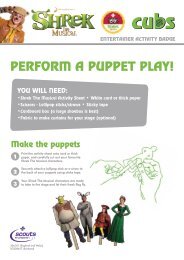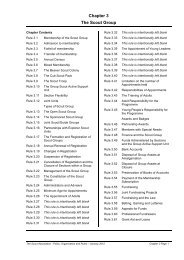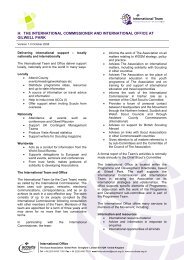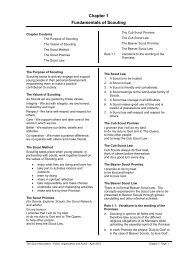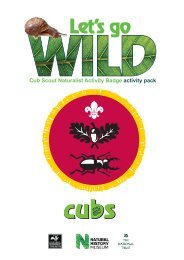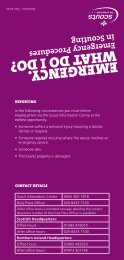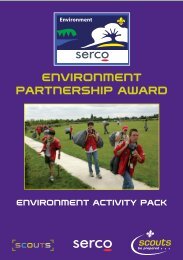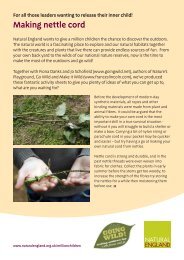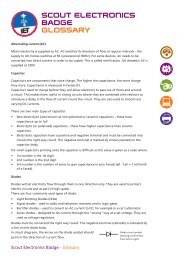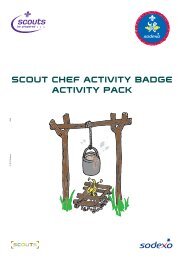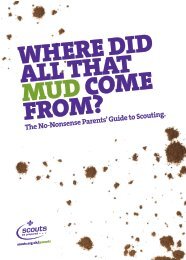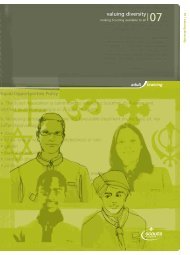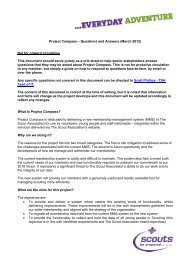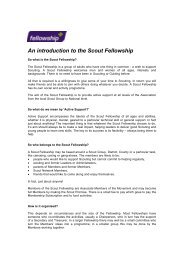Scout ExpEdition challEngE BadgE activity pack
Scout ExpEdition challEngE BadgE activity pack
Scout ExpEdition challEngE BadgE activity pack
You also want an ePaper? Increase the reach of your titles
YUMPU automatically turns print PDFs into web optimized ePapers that Google loves.
<strong>Scout</strong>ExpeditionChallengeBadgeActivity <strong>pack</strong>
THE BADGE REQUIREMENTSTo earn your Expedition Challenge Badge, you must take part in an expedition spread over two days, including a night away.The activities in this resource <strong>pack</strong> will help to ensure that you are:• involved in planning the expedition• trained in the essential skills• properly preparedPlay a full part within a team.Travel for at least four hours each day.Use a map to keep track of where you are.Stay overnight at a hostel or other suitablevenue, or camp overnight at a suitable site.Cook the evening meal and breakfast.Achieve at least one goal, as agreed withthe <strong>Scout</strong> leader beforehand.page 3 • <strong>Scout</strong> Expedition Challenge Badge Activity Pack
Activity 1A Global ChallengeOn page 15 of this <strong>activity</strong> <strong>pack</strong> there is a collection of pictures taken on expeditions and adventures from across the world to show youwhat is possible. Use these as inspiration to come up with your ideal expedition below.My ideal expedition:Activity 2Preparation is keyWhen undertaking any expedition of this kind, detailed planning is essential. This <strong>activity</strong> is designed to reinforce the importanceof thorough and careful preparation.Key aspects of preparation:page 4 • <strong>Scout</strong> Expedition Challenge Badge Activity Pack
Activity 3SETTING CLEAR OBJECTIVESThis <strong>activity</strong> aims to demonstrate the importance of setting clear objectives at the beginning of the planning stage. It should help withunderstanding the importance of correctly planning your own expedition.Our expedition objectives:Activity 4Building TeamworkAs well as building teamwork abilities, this game will also outline the need to respect the communities that you may visit during yourexpedition, whether they be at home or abroad. During the <strong>activity</strong> you’ll have the opportunity to simulate meeting people from othercultures. It will help to illustrate the qualities needed to work together with those who have different skills.Key aspects of teamwork:After the initial set of activities ......you should have an understanding of what makes a good team. The moment has arrived! It is now time for you to splitinto your groups for your expedition. We believe that small groups are easier to manage and organise so suggest a groupmaximum of four or five. Work with your leader to choose and organise your expedition groups.page 5 • <strong>Scout</strong> Expedition Challenge Badge Activity Pack
Activity 5Building your expedition teamThis <strong>activity</strong> is here to help you identify what roles each team member will take and what job they will be doing.Roles needed for the expedition:My role:Activity 6Expedition planningHaving looked at teamwork and created the groups for the expeditions, now we need to move on to planning the actual expedition.During the trip each group will need to walk for at least four hours a day over a two-day period. The following exercises are designedto help your group work out what they can achieve and how far you can walk while on your expedition.Speed of group:Terrain Distance walked Time taken kmph mphflatslightsteeppage 6 • <strong>Scout</strong> Expedition Challenge Badge Activity Pack
Activity 7Map work QuizThis <strong>activity</strong> will help you and your team to identify key symbols and notifications on a map. It should also help with planning a suitableroute, as well as teaching you how to navigate using a map while on your expedition.You have a map of Bodmin Moor on page 17 of this <strong>pack</strong>. Use this map and answer the questions below.Questions:1. What do the square lines drawn on themap represent?6. Name two of the villages7. Identify a heritage interest point2. What do the contour lines drawn on themap represent?8. If you followed the path (red dotted line) fromCodda to Westmoorgate, what direction wouldyou be travelling?3. Identify a road4. Identify a river5. Identify the highest peak9. Near what village is there a caravan and camping site?10. Is the River Fowey flowing north or south?How to fold a mapWhen working with a map it is really important to fold itand orientate it to the direction you are facing.See example to the right or try yourself with assistance.page 7 • <strong>Scout</strong> Expedition Challenge Badge Activity Pack
Activity 8The Treasure huntFollow instructions from your leader and see if you can find the treasure.Now you should understand how to read a map and the key symbols. You have also learnt to orientate a map to the waythat you are facing. Map reading is still a very important skill even with the onset of new technologies that bring routeplanning software into cars and telephones. This technology is very clever; it can tell you where you are and how to get to yourdestination, but how does it actually work?Activity 9Satellite NavigationWhen you think of GPS (Global Positioning System) you probably think of sat-navs and smartphones, but actually GPS worksin a very simple way.This exercise aims to show you how GPS works and to provide some location support if needed. Read more on page 16.When GPSgoes wrongBy AN Otherwww.ExtraNewspapers.comA Weston-Super-Mare barman receiveda humorous surprise last week when abedraggled American tourist turned upat his pub, named after a famouslocal landmark.The 30-year-old woman, whose nameis unknown, started off in Bath, England,with the intent of driving to WindsorCastle, Berkshire. It was supposed to bea medium length trip of around 90 miles,which should have taken approximatelytwo hours.About 130 miles and many unexpectedturns later, she finally ended up at WindsorCastle. Only it was The Windsor CastlePub in Weston-Super-Mare, a differentcounty altogether!Pub assistant manager, AnthonyCassidy told the newspaper an Americanwoman came in and asked if the pub hadWi-Fi. ‘I said it didn't and asked if I couldhelp her. She said she had wanted to travelto Windsor Castle and had ended up here.I told her it was Windsor Castle, butprobably not the one she was looking for.I have always wanted someone to come inand say that, and it has finally happened.It was funny because she had her sat-nav,iPod and phone and even with all thattechnology, she ended up here.’page 8 • <strong>Scout</strong> Expedition Challenge Badge Activity Pack
Activity 10Navigation at nightIf you find yourself out walking when the sun has set and the stars have come out,you need some way of understanding where you are and where you are walking.Finding north at nightThe two right-hand stars of the Plough are known as thepointers. Extend an imaginary line between them and out ofthe Plough and they’ll point to the Pole Star, also called Polaris.Polaris is always due north (in the northern hemisphere).If any of your group or family areinterested in astronomy or an astronomyholiday then head towww.astronomytours.co.ukor use a smartphone to access thetrip below.Activity 11Plan individual routesNow it’s time to plan the individual routes that you are going to take.Packing and ProvisionsExpeditions at different times of year provide us with different challenges. It’s important to bear this in mind whenplanning an expedition.Activity 12Clothing RelayThe aim of this exercise is to help you understand what clothing to wear on an expedition and how to choose clothesto cope with changes in expedition conditions.• The comfort/base layer. Worn next to the skin, to eliminatemoisture. Natural fibres such as cotton don’t have thisquality due to high absorbency. A good example of acomfort/base layer is a thermal shirt, a bad exampleis a cotton T-shirt.• The warmth/mid-layer. Mid-layer garments should provideextra heat insulation or act as a transport layer in warmerconditions. A good example of a mid/warmth layeris a polyester fleece, and a bad example isa denim shirt.• The protection/top layer. The top layer is the weatherprotective layer. There can be two types, the shell layer,which is for moderate conditions and the outer layer,which is designed for more severe conditions. A goodexample of a protection layer is a waterproof orbreathable jacket, and a bad example is a nylon(non-breathable) jacket.page 9 • <strong>Scout</strong> Expedition Challenge Badge Activity Pack
Activity 13Packing as a team exerciseThis <strong>activity</strong> will showcase how additional weight can impact your team’s speed.TO NOTE...20kg – This is the maximum weight porters willcarry up Kilimanjaro on a trekking trip. This is muchmore than we would expect a <strong>Scout</strong> to carry.Having looked at the importance of wearing the right clothes and carrying a complete first aid kit,what other items do you need to take on your expedition?Discuss with your team and your leader how to work out what other items you would need to take – don’t think about food just yet.ItemUsepage 10 • <strong>Scout</strong> Expedition Challenge Badge Activity Pack
Your food list:Activity 14First Aid Kit ExerciseThis exercise will help confirm the importance of a first aid kit and all of its contents and the injuries that each piece of thekit is suitable for.Item Use How to preventSuggested first aid Kit:A first aid kit shall be carried by the group at all times.As a minimum it should contain the following:• 10 adhesive dressings• 3 medium sterile dressings• 1 large sterile dressing• 1 extra large sterile dressing• 1 sterile eye pad• 2 triangular bandages• 2 crepe roller bandages• 6 safety pins• 1 pair plastic or surgical gloves• 1 pair of tweezers• 1 pair of scissors• Wound cleansing wipes• 1 notepad and pencil / penThe first aid kit should be kept in a sealed, water-tight container. the contents of thefirst aid kit should be checked and replenished before every expedition.page 11 • <strong>Scout</strong> Expedition Challenge Badge Activity Pack
Activity 15The Cooking exercisePlease turn to p14 where you have a couple of recipes. These are cheap and easy recipes that you can make before your expeditionand take with you in a plastic container. This will save you valuable <strong>pack</strong>ing space.So how much food do you take?Provisions will probably make up a large bulk of your <strong>pack</strong> weight, so it is important to judge the correct quantities to take with you. Updatethe <strong>pack</strong>ing and provisions sheet with the items you’ll be taking.Food name/typeNuts, salted or unsaltedPorridge or oatsHoneyCustard powderCheeseDried fruit/seedsInstant HorlicksTinned hamPastaInstant/cuppa soupsInstant noodlesInstant mashTomato sauceNotesNuts contain plenty of kcals (kilocalories) and have protein and oils.Makes an excellent slow-release energy food for breakfast, especially when honey, sugaror dried fruit are added.Easy to transport and store. Add to drinks or other foods for instant energy.Add to oats for a nice pudding.Very high-fat hard cheese in a block or squeeze cheese in a tube.Great to snack on, massive variety on the market and can help you avoid constipation.This drink contains a lot of kcals and doesn’t require milk, contains vitamins and minerals and canbe drunk or added to porridge.Huge kcals in a small tin, but it is salty. Don’t forget the tin opener!Bulky but light and a great source of slow-release energy.Use these as a sauce for pasta, or as a quick snack.Can be cooked in boiling water or eaten dry as a very high carbohydrate snack. If eaten dry youmust be to sure rehydrate well. 500kcals per 100g.Quick and easy.Add to pasta or instant mash for flavour. Contains sugar.Measuring Quantities25g (1 oz) flour, cocoa, custard powder = a well-heaped tablespoon25g (1 oz) sugar, rice, butter, fat (lard) = a level tablespoon250ml (approx. half a pint) = a normal camp mug fullThe camp mug measureYou can use a half-pint ‘camp mug’ for measuring all sorts of quantities. When a half pintcamp mug is filled it will hold the following approximate weights.125 g (5 oz.) flour200 g (8 oz.) sugar100 g (4 oz.) grated cheese175 g (7 oz.) rice150 g (6 oz.) dried fruitpage 12 • <strong>Scout</strong> Expedition Challenge Badge Activity Pack
Top Expedition Tips• Travel with a like-minded group.• Have a detailed plan. Know where you should be atwhat time.• Enjoy your journey. Interact with your surroundings andthe people you meet.• Work as a team, <strong>pack</strong> as a team.• Take a first aid kit.• Check weather conditions, but prepare for the worst.• Share your route, make sure someone at base knowsyour plan.• If you have a smartphone then save space bydownloading a compass, weather and so on.• Leave only footprints, take only pictures.ChecklistYou are now ready to embark on yourexpedition. If you stick to the plan and review itregularly then you are ready for departure.Key things to review pre departure are:WEATHER CONDITIONSROUTE PLANPACKING LISTPROVISION LISTCONFIRM ACCOMMODATIONLEAVE A COPY OF THE ROUTE PLAN WITHRESPONSIBLE ADULT OR GROUP LEADERHave a fantastic expedition!page 13 • <strong>Scout</strong> Expedition Challenge Badge Activity Pack
APPENDIXRecipesCreamed CornINGREDIENTS1/2 large onion, finely chopped2 tbsp butter8 ears corn, husks and silk removed1 tsp (teaspoon) sugar1/8 tsp nutmeg1/2 cup creamCoarse salt and freshly ground pepperMETHODIn a large saucepan, melt one tbsp of the butter on medium heat. Addthe chopped onions and cook two to three minutes until translucent.While the onion is cooking, remove the kernels from the corn. Stand acorn cob vertically over a large, shallow pan (like a roasting pan). With asharp knife, use long, downward strokes to remove the kernels from thecob. Use the edge of a spoon to scrape the sides of the cob to removeany remaining pulp.Add the corn to the onions and butter in the saucepan. Add two tothree cups of water and the remaining one tbsp of butter. Bring to asimmer, reduce heat and cover. Cook for 10 to 15 minutes, until thecorn is tender. Add the sugar, nutmeg, and cream to the corn. Cook,uncovered, for five to six minutes, stirring occasionally. Add salt andpepper to taste.Serves six.Quinoa SoupINGREDIENTS2/3 cup quinoa2 cups water2 tbsp (tablespoon) olive oil1 yellow onion, chopped1 carrot, julienned1 leek, white part cut in half, rinsed and cut2 cloves garlic, minced½ -1 red chilli pepper1 can (400g/15oz) crushed tomatoes4 cups vegetable stock(or 4 cups water and 2 stock cubes)salt and pepper to tasteMETHODHeat the vegetable oil in a large pot on medium-high heat. Stir in thequinoa, carrot, celery, onion, chilli pepper, and garlic. Cook for a fewminutes, until lightly browned, stirring frequently.Pour in the vegetable broth, water, tomatoes, and cabbage. Increaseheat to high and bring to a boil. Reduce heat to medium and simmeruntil the quinoa and vegetables are tender for about ten minutes.Season to taste with salt and pepper. Garnish with parsley beforeserving.Serves six.page 14 • <strong>Scout</strong> Expedition Challenge Badge Activity Pack
Global Challengepage 15 • <strong>Scout</strong> Expedition Challenge Badge Activity Pack
APPENDIXGlobal Positioning System (GPS) - How it worksIntroductionWhen people talk about a GPS, they usually mean a GPS receiver.The Global Positioning System (GPS) is actually a constellation of27 earth-orbiting satellites (24 in operation and three extras in caseone fails). The US military developed and implemented this satellitenetwork as a military navigation system, but soon opened it up toeverybody else.Each of these 3,000-4,000 lbs solar-powered satellites circles theglobe at about 12,000 miles (19,300 km), making two completerotations every day. The orbits are arranged so that at any time,anywhere on Earth, there are at least four satellites visible in the sky.A GPS receiver’s job is to locate four or more of these satellites,figure out the distance to each, and use this information to deduceits own location. This operation is based on a simple mathematicalprinciple called trilateration. Trilateration in three-dimensional spacecan be a little tricky, so we’ll start with an explanation of simpletwo-dimensional trilateration.How trilateration worksImagine you are somewhere in the UK but you have absolutely noidea where you are. There are no distinguishing landmarks and soyou have no way of finding out where you are on a map of the UK.You ask a local where you are and they say 100km from Bristol.With this information as a starting point, you’ll know that you aresomewhere on a circle around Bristol with a radius of 100km.You then ask somebody else where you are, and they say you are70km from London. Now you are starting to get an idea. If youcombine the information from the first and second person on themap, you should have two points at which the circles intersect. Youmust be at one of these points.If you ask a third person where you are and they say 130km fromBirmingham, this will tell you exactly where you are. In this case, ifyou are 100km from Bristol, 70km from London and 130km fromBirmingham you must be about 20km south west of Reading. Tomake sure the reading is accurate you can find out the distance fromanother point. If you asked another local and they told you that youwere 50km from Southampton, you would be able to plot this andcheck your earlier readings.This is the principle behind GPS, except GPS usesthree-dimensional trilateration.Satellite Navigationpage 16 • <strong>Scout</strong> Expedition Challenge Badge Activity Pack
MAP workpage 17 • <strong>Scout</strong> Expedition Challenge Badge Activity Pack
APPENDIXROUTE PLAN• To be completed in accordance with Policy, Organisation and Rules.Route PLAN• Take a copy with you and leave a copy with a responsible local person –cancel on return.Date Day ....... of ........ or One day Maps used:Objective: Magnetic variation:Place or grid referenceMagneticbearingDistance(km)Heightgained (m)Description of routeEst. timefor legTotal timeStartToToToToToToToToToTotalsAdd 10 minutes per hour for safety ... thus estimated total journey timeStart time Finish time or reach campsite Dark atTeam RolesName Rolepage 18 • <strong>Scout</strong> Expedition Challenge Badge Activity Pack



